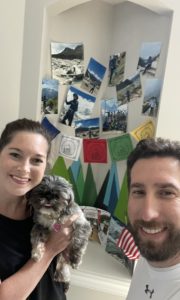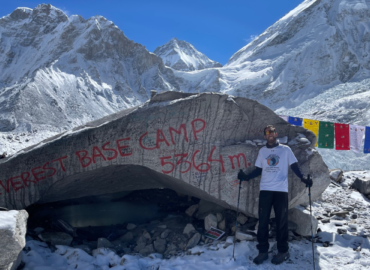
WELCOME TO THE WORLD’S HIGHEST MARATHON
THE LEAD-UP: “I NEEDED TO GO…THE PULL OF EVEREST WAS STRONGER FOR ME THAN ANY FORCE ON EARTH.” -TENZING NORGAY
After running some of the most adventurous races on the planet, I felt mentally prepared for this race. Back in 2016, I had just completed the Antarctica Marathon with my running group and I thought they were joking about a marathon on Everest. Maybe the freezing Antarctica water had gotten to their brains or maybe we were all too many drinks in, but I asked several times “Is there really a marathon on Mount Everest!?”
In total disbelief…I Googled it. Sure enough, “The Tenzing-Hilary Everest Marathon was started in 2003 to celebrate the 50th anniversary of the first successful ascent to the top of the world, Mt. Everest, and to commemorate two of the most iconic legends of the mountains: Edmund Hilary and Tenzing Norgay Sherpa.”
This was instantly added to my bucket list.
Fast forward to December 2019 when the world was officially introduced to Covid-19. 2020 came and went like ships passing in the sea at night. 2021 quickly turned into a postponement for 2022 and serious second-guessing began to creep into my mind for the following reasons:
- This would be marathon #13: Was this a sign to maybe focus my cause elsewhere?
- Plane crashes were sadly common in Nepal and we were flying in and out of the World’s Most Dangerous Airport
- Could I handle the altitude and run 26.2 miles beginning at 17,600 feet?
- Would I make the cut-off at mile 20 in 9 hours or less?
- Was I going to die?
This is what happens when you have years and years to overthink the room. However, when I finally received a confirmation email in March that the race was going to happen, my mind immediately shifted and focused on one goal: to run the highest marathon in the world!
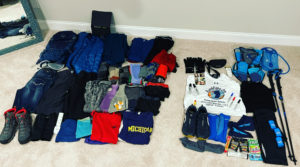
EVEREST BASE CAMP: “JUST TO LIE HERE IN THE SUN WITH THE GREAT WHITE PEAKS ALL AROUND ME AND THE BIGGEST GLACIER AT MY FEET…IT IS A HEAVENLY EXISTENCE.” -GEORGE LEIGH MALLORY
The trek to Everest Base Camp was incredibly challenging and took 11 days, traversing 70+ miles of incredible terrain. Flying into the World’s most dangerous airport was something I was glad to check off my bucket list, and also, something I never want to experience again. Both of these experiences deserve attention, and they will be shared in great detail in my next blog.
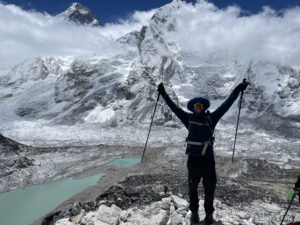
Everest Base Camp, aka EBC, is truly one of the most magical places on earth! I would almost equate it to a mini pop-up city constructed at the foot of the world’s tallest mountain. While there are plenty of trekkers that make it up to EBC, there are only two groups of people that can sleep at EBC: hikers looking to summit Mount Everest and Marathon (and ultra-marathoners) runners. Any hiker who arrives at EBC can spend 1-2 hours before they have to turn back around and make their descent.
One of the first things I noticed walking up to base camp surrounded by picture-perfect Himalayan mountains is the famous yellow tents. While I’ve seen these images time and time again in movies and put my eyes on countless snapshots of them in books, the only word that comes to mind is surreal.
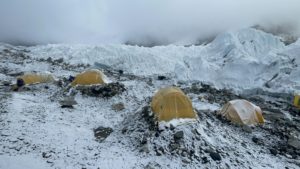
Each runner shares a yellow tent with the same person they shared lodging with during the trek up to EBC. For me, that was my newfound friend Mark from Philly. We quickly got situated in our home for the next two days and nights. When the sun was up, you could surprisingly wear shorts and a T-shirt, but when that sun dropped down behind the mountains, you better be covered from head to toe and layered up!
At 6 pm, our group walked approximately 100 feet and had a wonderful dinner in a large tent. Following our meal of soup, fried cauliflower, potatoes, and rice, I filled my hot water bottle up, and walked over to my tent. I put on four or five layers and was still freezing. The temperature was dropping and it felt below zero inside that tent. I was too cold to get up in the middle of the night to go to the makeshift bathrooms (a stand-up tent with a bucket that was flush ground) so I waited until sunrise.

Snow had fallen overnight and the entire base camp was covered in several inches of fresh powder. My first thought: we are in a snow globe. My second thought: thank god the race isn’t until tomorrow!
After breakfast, everyone put on their race gear and we made our way to the start line which is a 10-15 minute walk.
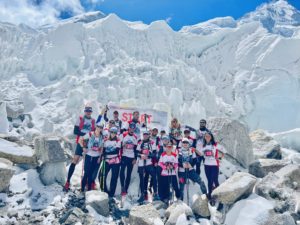
After our photoshoot, all we had was time on our hands. Time to walk around and take pictures and videos. Time to relax in our tent and ponder the race ahead. Time to just sit and relax. More than anything, I was taking time to soak in this once-in-a-lifetime setting.
Tomorrow was going to be special. I was ready to walk out of that famous yellow tent and run against dementia…at 17,600 feet.
RACE DAY: “PEOPLE DO NOT DECIDE TO BECOME EXTRAORDINARY. THEY DECIDE TO ACCOMPLISH EXTRAORDINARY THINGS.” -SIR EDMUND HILLARY
MILES 1-3: SINGLE FILE AND SLOW MOVING
After patiently waiting 1,825 days, I didn’t have to wait any longer. I slept two hours before the 4 am alarm went off in our tent, but I was ready to go! I walked to the breakfast, downed some porridge, inhaled a few pieces of white bread with peanut butter, and drank plenty of electrolytes.
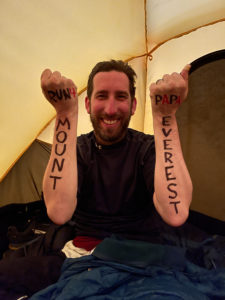
My race bib was #29. This race is always on May 29th celebrating the historical successful ascent of Mt. Everest. If nothing else, it was an odd number and a better omen!
In my heart of hearts, I felt today was going to be epic. My mindset was to finish on Day 1. As a reminder, if runners don’t reach mile 20 in 9 hours or less, they have to sleep overnight and continue their race at 6 am the next day, incurring a 3-hour penalty.
In our 20-person trekking group, I had become close with a fellow runner named Brian from Brooklyn. Brian is a personal trainer who had recently run the Polar Circle Marathon and had a hilarious personality. During our trek to EBC, we decided we would do something neither of us had ever done before in a race: run the entire thing together. In past races, I would always run alone and at my own pace. But Everest commands a different level of respect and we both thought having someone else to feed off during this journey would be immensely beneficial. While we are both beyond directionally challenged, we believed that somehow, someway, we would avoid getting too lost and find our way to the finish line in Namche Bazar. My only ask of Brian was, “Please don’t tell me what mile we are at or how long we have been running until we reach the cut-off point.”
Two sherpas held a long piece of tape across the start line and at exactly 7 am the race began. The Nepalese runners sprinted off as if the terrain were perfectly flat. For us normal runners, we had to carefully make our way through EBC in a relatively single-file fashion looking down at every step to avoid rolling an ankle or stepping into a half-frozen glacier pond.
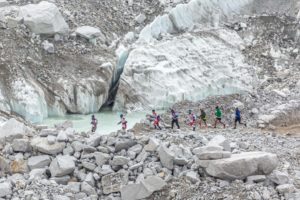
One misstep and your race would be over. Trekking poles were such an essential part of this race (and during the hike up for that matter). How Brian hiked up to EBC with only one pole and ran with that one pole will forever boggle my mind. To be fair, he never once complained about it.
Nonetheless, we made our way down and up through the first 3 miles traversing over massive boulders and slippery rocks with the Himalayan Mountains as our backdrop. First checkpoint: Gorakshep.
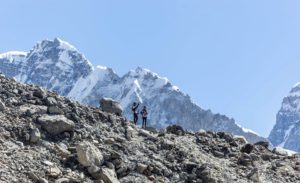
MILE 4-8: NO DIRECT PATHS AND ALMOST A MASSIVE MISTAKE
With only 150 people running the marathon, the field starts to separate fairly quickly after the first few miles. As a runner, I am used to seeing mile markers (or kilometers in this part of the world) along the way. At Mount Everest, the only markers are an occasional ribbon tied to one small branch on a tree. My compass revolved around trying to spot these ribbons, attempting to keep pace with other runners in my line of vision, semi-relying on Brian’s GPS, and hopefully not veering off in the wrong direction.
The game plan was simple. We would walk up every major incline and run/speed walk every “Nepali flat” piece of terrain. Nepali flat is code for any “flat terrain.” To be clear, there is no flat terrain on this race course.
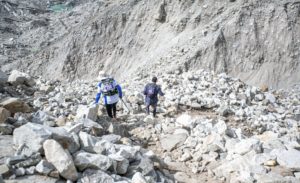
As we were making our way down a steep and rocky path, we came across a guy called “Tigerman.” He was running with this massive tiger mascot costume on the back of his body. His goal was to promote saving Tigers while also cross-promoting his running company. While I always admire anyone who runs for a particular charity and cause, this guy’s outfit was preventing Brian and me from passing him.
Brian looked at me and said, “We are doing a strategic takeover.” I was laughing so hard inside but completely understood what he meant. This strategic takeover would be said many times through the next 20 miles.
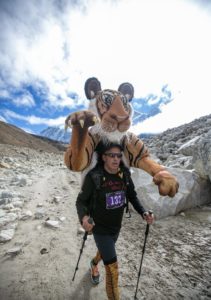
We were navigating the unforgiving terrain and knocking out mile after mile. When we approached Thukla Pass, we took a minute to pause and honor the 100+ rock memorials made as a tribute to climbers and Sherpas who lost their lives in the mountains.
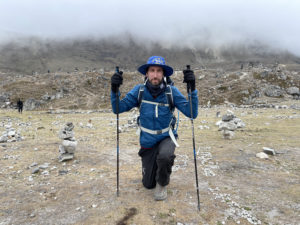
After making our way through Thukla Pass, we were intending to veer right and head down the mountain. Instead, we saw trekkers motioning us to go left and run uphill. We didn’t see any runners ahead and we had separated our distance from the ones behind us.
We trusted the trekkers and this decision literally saved us. Had we continued going down the mountain to the right, we would’ve easily run a mile or two and then would’ve been forced to double back UP the mountain. This mistake would’ve cost us a minimum of 60-90 minutes along with a crippling emotional blow to our psyche. Major kudos to these trekkers for your good karma, and all the trekkers along the way, who were all so encouraging.
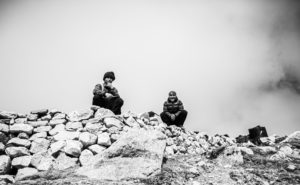
MILES 8-13: HUGE OPEN AREAS, THE WRONG MILE 13 AND THE BIBRE LOOP
The next part of the race was both gratifying and gut-wrenching. First, the fun part! When heading toward Dingboche (which is the halfway point of the race), imagine Mount Everest as the backdrop and miles and miles of Nepali flat open terrain in front of you.
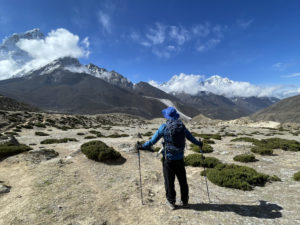
Brian and I would identify a particular spot in the distance and run toward it. Once we arrived at the “target,” we would choose another one and continue this process throughout this open field. I was pretty optimistic at this point because Dingboche = 13.1 miles…or so I assumed.
Upon arriving in this town, we saw our Nepalese group leader, Bhim, waiting for us at the checkpoint. He was helping runners replace their fluids, handing out chocolate, bananas, and granola-type bars. For the race to qualify as an official marathon distance, the route includes an out-and-back known as the Bibre Loop. This portion of the race is 3.7ish miles, famed for mentally derailing runners because you go up in elevation.
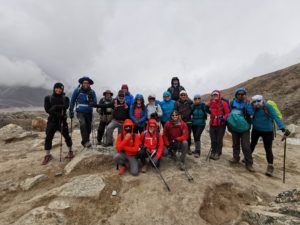
When you reach the end of the Bibre Loop checkpoint, race officials place a red bracelet around your wrist and place a checkmark next to your name and bib number on their spreadsheet.
The only thought going through my mind: once we come back we will be at mile 17. Brian and I headed toward Bibre Loop and were passing a bunch of runners, including my friend Mark from Philly, who were already making their way back from the loop. I have to say this was very deflating. While I was happy for my fellow runners and friends, the Bibre Loop rock seemed so far away, almost like a mirage.
To compound this anxiety, Brian was running at a feverish pace and I pleaded with him (numerous times) to slow down. I thought he was pushing the pace way too quickly, especially in one of the most challenging areas of the entire race. He finally looked at me and said, “you’ve run the Great Wall, Big 5, and Antarctica, come on man, step it up!” Oh boy, did that light a fire under me. I was genuinely pissed off at him and said, “you can run ahead, I don’t want to hold you up.”
Brian emphatically responded that he wasn’t leaving me behind and kept motivating me to push forward. With his resolute conviction, I was able to run at his insane pace which paid off. We hit our checkpoint in 34 minutes! I was ecstatic, placed the red bracelet on my wrist, and ran back toward Dingboche in 18 minutes flat.
I was floored. I couldn’t believe how fast we ran that out and back. And then Brian told me…“Ummmm. I hate to tell you something because I know you don’t want to know what mile we are at, but that out-and-back got us to mile 13, not 17.”
Surely, he was joking, right?
He wasn’t. Instead of complaining or being frustrated by this update, I immediately focused my attention ahead on the remaining 13.1 miles. Brian told me to leave my fleece with Bhim and said, “you won’t need that, we are finishing today!”
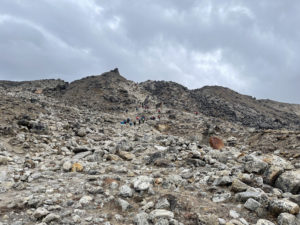
MILES 13.1 – 20: PLAIN AND SIMPLE…MAKE THE CUT-OFF!
The next 7 miles felt like cruise control.
I recall Brian asking numerous times, “do you want to know what time we are at?” I didn’t. My main focus was on making the cut-off. Here are a few takeaways from this section:
- S.E.R.F. (Scientific Everest Race Formula) – Dropping elevation + gaining oxygen levels = getting stronger mile after mile
- Giant rock edifices with inscriptions are called Mani stones. These stones are positioned singly along the trails and rivers as an offering from hikers/runners to the local spirits. Our guides always told us to keep them to our right when passing, walking around clockwise, the rotational direction of the earth and the universe revolve around Buddhist beliefs.
- “Strategic Overtake” of runners makes sense, but not of Sherpas. We overtook a sherpa carrying one of the famous red trekking bags on his back. Less than 5 minutes later, he was doing a strategic overtake on us.
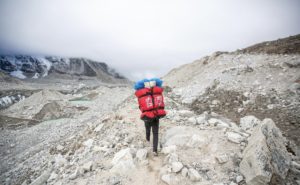
- Take time to stop and appreciate your surroundings because it is super easy to run miles at a time without ever looking up.
- Pro Tip: two sets of eyes on the course are surely better than one set. Having a running partner-in-crime kept me sane. We laughed, we joked, we complained, and then laughed some more.
- While Brian never divulged our actual running time, he would occasionally say, “we did that mile in 30 minutes 17 secs, or 23 minutes 41 seconds” which was his sneaky way of saying we were making better time than expected.
- The cutoff is 100% in the back of your mind. If you don’t make the cutoff, besides being an emotional and physical nightmare, you have to do the following:
- Find a lodge to sleep in – the race organizers do not organize this on your behalf
- Sleep in the same sweaty clothes
- Wake up at 5 am
- Hike up a mile to the restart
- Run 6.2 miles in the morning
- Mile 19 begins a long trek up a winding set of “Everest steps” leading runners through a covered maze of trees. At the very top of this seemingly never-ending path through a Sherwood Forest was Tengboche! When you emerge from the forest, a massive monastery captures your eye along with the most beautiful checkpoint in all the world: Mile 20!
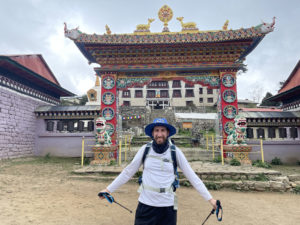
“OK Brian, what’s our time?” He said, “7 hours and 45 minutes.”
The anxiety melted off my shoulders because I knew we were guaranteed to be a Day 1 finisher provided we treated the remaining 6.2 miles with the utmost respect.
I assumed we would finish late in the evening and was focusing my mind and body on the daunting challenge ahead.
MILES 20-26.2 #SLOWANDSTEADY #DON’TBEAHERO #DONTDIE
Most people understandably assume this race is all downhill. Let me say with the utmost conviction and experience, that it is not. In fact, 12,000 feet of the race is downhill, BUT 6,000 feet is uphill.
Reaching Mile 20 is one thing, but what comes next might arguably be one of the toughest parts of the entire marathon. I began heading downhill on what felt like a 40-degree decline of never-ending switchbacks. I have no clue how Brian made his way down without falling because I was using all the power in my calves coupled with my trekking poles to stay upright. I would walk about 20 feet, swing around a tight curve, and repeat this process time and time again.
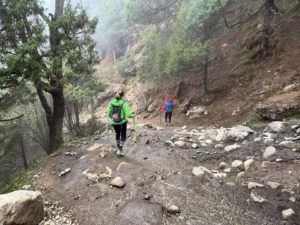
With the weather turning quickly, I kept pushing my legs downhill hoping to eventually see the suspension bridge at the bottom of this path. At long last, I saw that swaying bridge and asked Brian how many miles we knocked off that descent. His response was, “0.8 miles.”
.8 miles! I was a deer in the headlights but knew sitting around and moping would only lead to a DNF (did not finish).
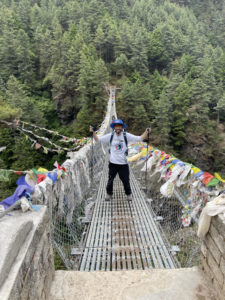
What exactly were we eyeballing in front of us? Just your standard 1.5-mile, 45-degree winding path heading straight up the mountain. This was why I only got two hours of sleep the night before.
This feels like the appropriate time to share the three hashtags we repeated in extraordinary tough spots during this race:#SlowandSteady #Don’tBeAHero #Don’tDie
Brian hit a wall. The next 1.5 miles could take 45 minutes or 1 hour and 45 minutes. While Brian had told me he was one to sprint out of the gate, I always preached to go #SlowandSteady, especially on the uphill sections. I have never started a race and not finished one and this was not going to be the first.
My good friends from South Africa (in our trekking group) would routinely say on our ascent to EBC, “#Don’tBeAHero.” The goal was to finish the race. Period. On Day 1 or Day 2. During the day or at night…just finish. And while this may seem like such an obvious take, the most important rule was #Don’tDie! Get back safely to your family. It is easy to lose sight of the bigger picture when you are constantly trying to push your body to experience things it has never gone through before.
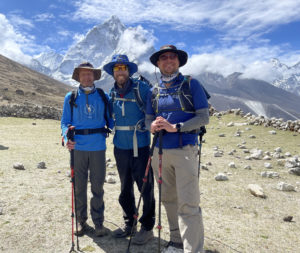
These three hashtags were especially poignant during this 1.5 mile ascent.
I knew how intense and funny Brian is as a person. As we continued to make our way up the mountain, I asked him if he had ever seen the movie “Lone Survivor” with Mark Wahlberg, Emile Hirsch, Ben Foster, and others. He responded in the affirmative and I knew I could use this as a healthy distraction. While he was answering my questions about how he would escape the enemy fire and figure out a way to get home to his loved ones, we were making solid progress up this mountain.
At that moment, I felt the most unusual epiphany…walking up these crazy inclines was far easier than going down them. I could control my pace, breathing, and energy. My mindset completely shifted and suddenly there were no breaks of 5-10 seconds of catching my breath. I was moving up this mountain with an overwhelming sense of confidence. if we picked up our speed, we would finish before sunset.
I was more motivated than ever to cross that finish line and not have to use my headlamp. At this point, I asked Brian to count down the last three miles. I was determined to knock them out as quickly as possible. After passing a slow herd of moving yaks, I saw about 50 different flags sitting on a waist-high rock wall. I grabbed an American flag, tucked it in my running pack, and made my way to the final homestretch. Brian’s GPS lit up informing us that we had 1 mile to go; however, seconds later a local supporter motioned to us to turn left and said, “the finish line is straight ahead.”
In total shock and disbelief, we turned left. Sure enough, the finish line was DEAD AHEAD! Somehow, someway, the GPS had been off by a mile.
For those of you who may not be aware, one of the most unique aspects of the Mount Everest Marathon is the finish line. As I ran through the tape that race organizers held up for each runner, I felt like I had won the entire race…
1,825 days later, I proudly crossed that line in 10 hours 41 minutes and 29 seconds as a Day 1 finisher!
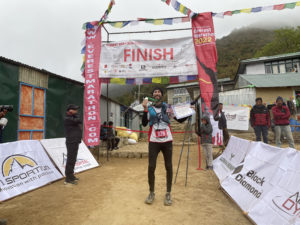
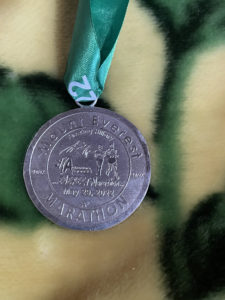
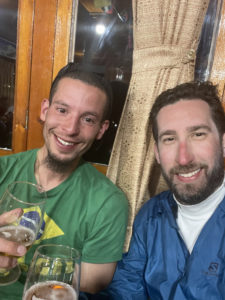
As I took my running shirt off, I couldn’t help but stare at the quote on the back of my shirt: “Everybody has their own Mount Everest they were put on this earth to climb. Mine is running to find a cure for dementia.”
To view more Run4Papa photos of this race, go to the 2022 Mount Everest Marathon
A special THANK YOU to everyone who contributed this year to fund our Global Dementia Trial as we ended up exceeding our $17,600 goal and raised $22,315!
